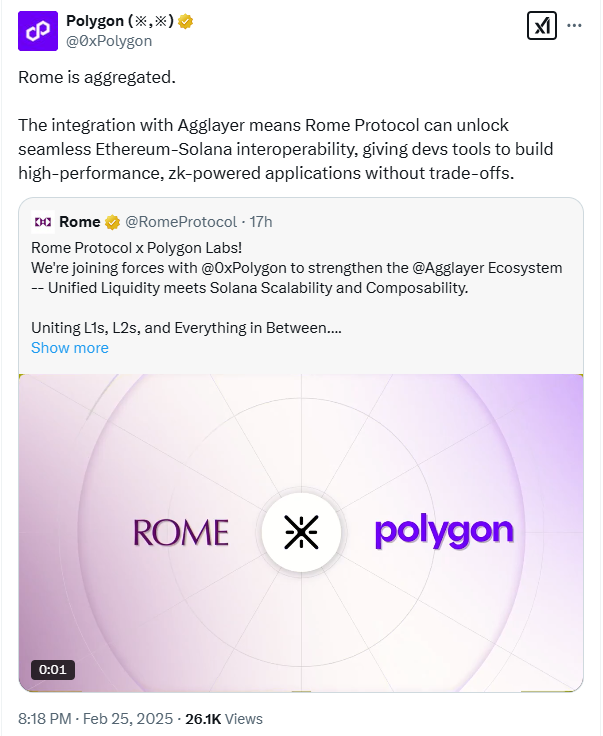- The interactions between Ethereum and Solana will gain a massive boost with the Rome and AggLayer partnership.
- With a focus on cross-chain interoperability, user security and liquidity will be improved across both chains.
Rome Protocol, a blockchain platform that modularizes Solana’s consensus into a service, recently formed a strategic partnership with Polygon Labs. Under this partnership, Rome will integrate Polygon’s AggLayer to enable seamless interoperability between Ethereum and Solana.
Integration Between Rome Protocol and Polygon
Rome Protocol’s collaboration with Polygon is geared towards a shared vision of creating a unified liquidity layer between integrated ecosystems. This collaboration gives developers access to tools to build high-performance, ZK-powered applications without trade-offs.
The partnership will leverage the expertise of both Rome and Polygon. Rome Protocol facilitates seamless cross-chain interoperability by integrating Solana’s composability and scalability into Layer-2 solutions, appchains, rollups, and network extensions.

On the other hand, Polygon’s AggLayer is a cross-chain protocol that connects different blockchains through a unified bridge. As we discussed earlier, AggLayer also introduces an important technology known as ZK proof, which enables the cryptographic verification of cross-chain transactions.
Therefore, Rome Protocol’s alliance with Polygon will focus on solving scalability and interoperability challenges while prioritizing user security. Funds can become stuck without proper interoperability, preventing users from moving their assets freely and securely.
Likewise, the lack of scalability results in decentralized consensus mechanisms taking more time to agree on a blockchain’s state. To solve these issues, Rome decided to rely on Solana’s qualities, including speed, low transaction cost, and a strong and distributed network of nodes.
Integrating the Rome Protocol and Polygon will focus on three key areas. Firstly, Rome EVM will use AggLayer as its Canonical Bridge to Ethereum. AggLayer’s unified bridge will handle all cross-chain communication and token transfers.
Secondly, AggLayer will integrate the Rome Stack as a cross-chain asset and message transfer solution between Ethereum and Solana.
This integration will give any blockchain that implements AggLayer a secure and simple way to communicate between Ethereum and Solana. It will also include functionality for Hercules to post rollups’ states to Ethereum, taking AggLayer’s interoperability to the next level.
The third aspect of the integration is for Rome RaaS Chains to use AggLayer as its Canonical Bridge to Ethereum and other AggLayer-connected chains. This integration allows Rome RaaS Chains to unlock instant communication and token transferability with every AggLayer chain.
What the Future Looks Like for the Rome Protocol
By integrating the AggLayer, Rome Protocol envisions a future where blockchains like Ethereum and Solana can interact with each other. This system will see networks, users, and everyone more connected in a secure ecosystem.
The recent partnership will see AggLayer as the main bridge for Rome EVM and Rome RaaS Chains. This means users can move their crypto smoothly and securely across networks, bringing liquidity together.
Finally, AggLayer introduces techniques such as zero-knowledge proofs (ZK proofs). The ZK proof ensures that every cross-chain transaction is cryptographically confirmed, improving user security.
Meanwhile, Polygon has chosen Agora AUSD as the native stablecoin for AggLayer. As noted in our earlier post, this move aims to enhance cross-chain liquidity and interoperability within the Polygon ecosystem.
Recommended for you:
Credit: Source link





